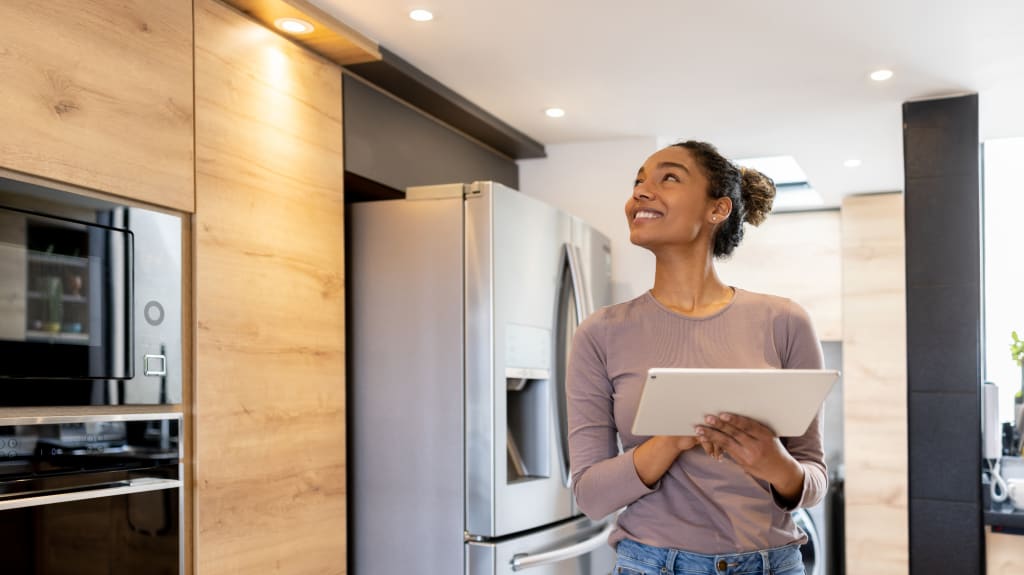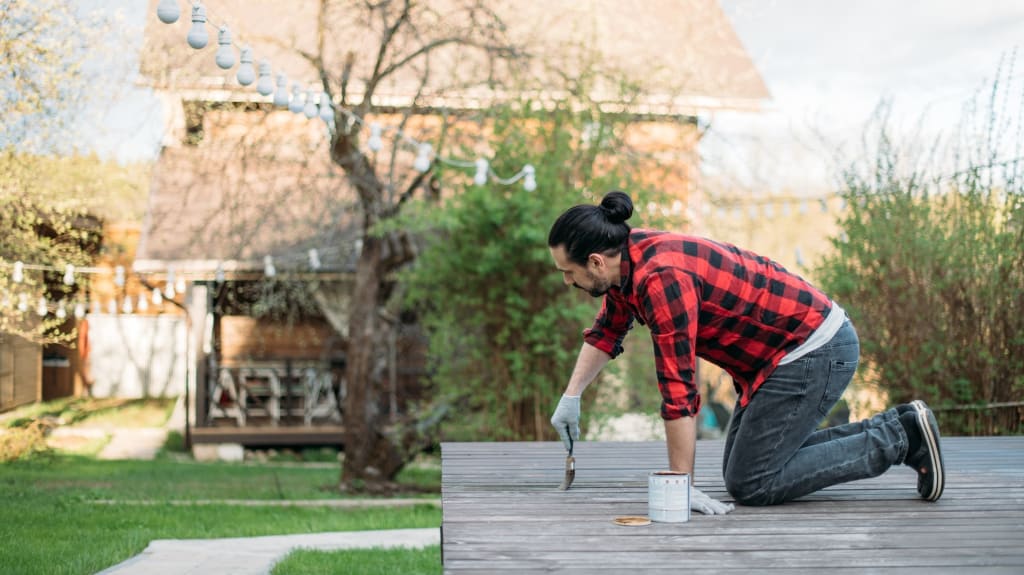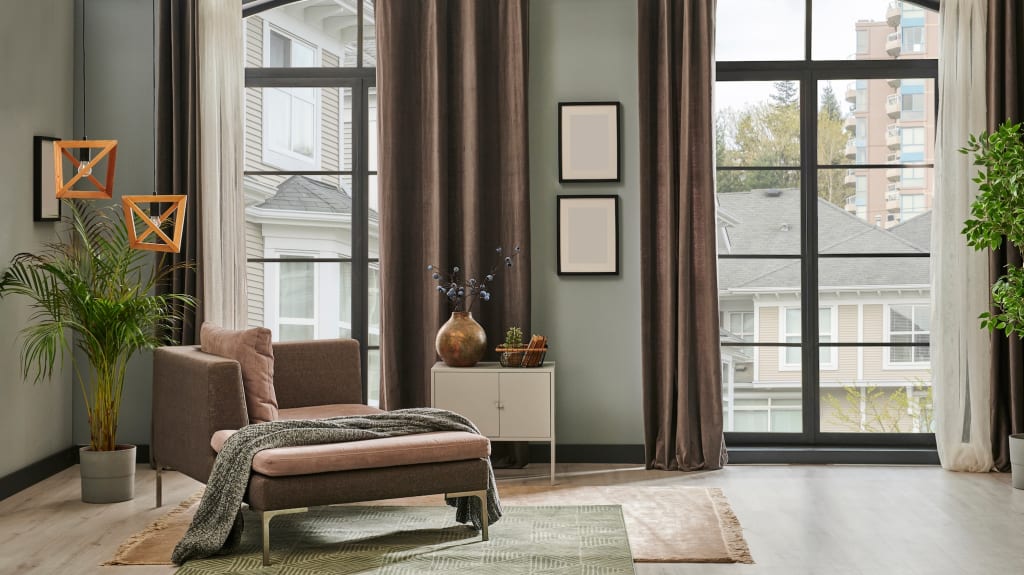Whether it’s in a small bathroom, wardrobe, or busy family kitchen, good lighting in your home is essential—but did you know there are 4 kinds? Below, we explore the different layers of lighting and how to choose the right type of light fixture for each room.
Why is light so important?
Light creates mood and enables us to see and perform everyday tasks. Imagine trying to be productive in a dark home office versus one that’s well lit with downlights and a desk lamp—there’s no comparison. However, what many of us forget (or don’t realize) is that, just as every room in the house serves a different purpose, the lighting requirements of each space are unique.
A room can have more than one function. For example, a kitchen can be used to prepare food, socialize with friends, or do homework after school. In the bedroom, we relax, indulge in hobbies, or sleep. Each of these uses requires one or more types of lighting from multiple sources, so a solitary ceiling fixture just won’t cut it!
4 types of light to include in your home
A well-lit area is one that features up to four layers (or types) of lighting: ambient, task, accent and decorative. Each of these fulfills various needs and ensures your home is always a comfortable, balanced and inviting living space.
1. Ambient lighting
General or ambient lighting illuminates an entire room without the help of additional light sources. For example, LED downlights in a living room or hallway will brighten the whole area, giving you enough light to see where you’re walking and what you’re doing.
Ambient lighting also decreases eye strain because it prevents one bright beam from contrasting with an otherwise dark room. Other fixture types that provide ambient lighting are chandeliers, wall-mounted, floor and table lamps, and track lights.

Ambient outdoor lighting is used for atmosphere, security and safety at night. With a backyard entertainment area, you could utilize a combination of lanterns, spotlights, path lights and wall-mounted fixtures to light up the house exterior, stairs and footpaths. This not only looks good (increasing aesthetic appeal), but also helps deter any suspicious activity near your property.

2. Task lighting
Task lighting is exactly that—light that enables you to perform a specific activity, such as reading a book, doing computer work, or preparing a meal. The gleam is usually bright and focused, such as with a desk lamp, pendant or directional recessed light. Like ambient lighting, task lighting is functional (rather than decorative).

3. Accent lighting
Your home should also have accent lighting, which is used to create ambiance, showcase specific features, improve your decor and reinforce design aesthetics. It directs your focus to the object in question, making it stand out. This could be anything from a unique piece of art or plant to an architectural element of a building.
This lighting will usually cast a narrower beam with a higher output, and can be achieved with track lights, directional recessed and wall-mounted fixtures, or slim line bars.

4. Decorative lighting
The last layer of lighting you can include in your home is decorative. Think of a beautiful statement pendant above your dining room table or a chandelier in the entryway.
Even when turned off, some pendants and lamps can double as art, sparking conversation and enhancing your decor. These fixtures stand out and create drama and impact, either by their colour, size, light or a combination of things. You can achieve decorative lighting in your house with pendants, wall sconces, table, and floor lamps.

How to choose the right type of light fixture for each room
Each space in your home should have more than one light source. Depending on the size of the room (and your budget), these are the kinds of fixtures you could include in your lighting plan.
Looking to install light fixtures? Have the work carried out by a specialized and verified electrical contractor thanks to the HomeExpress online referral service provided by RenoAssistance.
Submit a request
Bedroom lighting
The bedroom is primarily for sleeping, but depending on your lifestyle, it can also be where you relax, work, and dress. If you like to read, wall-mounted lights with adjustable arms on both sides of the bed will let you focus the glow where needed. To keep the atmosphere tranquil, avoid a harsh ceiling fixture and opt instead for wall sconces and floor lamps with shades. For the closet, a bright ceiling-mounted or recessed fixture will illuminate the area.

Bathroom lighting
If you need to shave or put makeup on, a single ceiling fixture in the bathroom will never be enough. Aside from recessed lighting (for overall illumination), include sconces above or on either side of the mirror. These will direct the gleam upwards or downwards, bouncing it around the room and preventing shadows from falling across your face. Don’t forget track lighting to highlight the unique feature wall behind the bath.

Kitchen lighting
The kitchen can benefit from several light fixture types because it’s usually the busiest room in the house and requires enough illumination for food preparation and cleaning. For ambient light, opt for a central ceiling fixture or a few recessed downlights, then consider an undercabinet system to brighten up the countertops, and soffit lighting (or valance) above the sink. This is where most of the “work” in the kitchen will happen, so excellent task lighting is a must.
The island is a prime spot for hanging pendants, but the fixture you choose will depend on how you utilize the space. If the island is your main workspace, you will need downward-pointing shades made of metal or frosted glass. The globe will block the light bulb from view, directing it straight down, so you can use a brighter bulb without hurting your eyes. However, if your island is a casual dining area, you could opt for a more decorative style of pendant with clear glass or a bare bulb.
For wow-factor and accent lighting in the kitchen, consider installing toe kick and in-cabinet fixtures. Lighting up your toe kicks with linear LED gives the stunning impression that your kitchen cabinets are floating. If they have glass fronts, place LED recessed or puck lights in the top and point them downwards. For open shelves, apply a LED strip on the underside of each shelf to light up the contents and create an eye-catching display.

Dining room lighting
In the dining room, the most important area is the table where parties are hosted, meals are shared, ideas are exchanged, and homework is completed. Even if it’s small, this space can benefit from at least three types of lighting.
A statement chandelier above the table will provide ambient, task and decorative lighting. However, recessed lights or wall sconces could also supply general illumination if needed. Ensure that the chandelier is at least half the width of your dining table (to add drama), and opt for a dimmer switch, if possible, as this will create mood and ambiance when entertaining. If there’s any art in the dining room, emphasize it with small puck lights or slim line bars.

Living room lighting
Layered illumination is particularly important in this space because we spend a lot of time here and use it for various purposes. We could be reading, watching TV after dinner, playing cards, or simply relaxing as a family after a long day. Instead of relying on downlights, work cove or valance lighting into the architecture. This is when globes are placed in a ledge, shelf, or recess of a wall, bouncing beams toward the ceiling. This eliminates shadows and creates a wonderful brightness—perfect for ambient lighting.

For task lights, a lamp in a reading nook or on a game table will do, while track lighting can highlight art collections, photos, and plants. If you’d like to call attention to a feature wall (whether indoors or outside), place fixtures (either on the ground or on the ceiling) against the surface. The light grazes the wall, drawing your eye to the texture of the tile, brick or stone.
Could friends or family also benefit from EspaceProprio’s expertise? Invite them to take a look at what we have to offer.




